Open Access Strategy in Cloud Computing-Based Heterogenous Networks Constrained by Wireless Fronthaul
Zhongyuan Zhao, Yong Li, Weiliang Xie, Min Wang, Wenbo Wang
1 Key Laboratory of Universal Wireless Communications (Ministry of Education), Beijing University of Posts and Telecommunications,Beijing 100876, China
2 China Telecom Technology Innovation Center, Beijing 102209, China
* The corresponding author, email: zyzhao@bupt.edu.cn
I. INTRODUCTION
Responding to the challenges of supporting the ever increasing high-speed data applications in future wireless communications, heterogenous networks (HetNets) have drawn a lot of attention in the research field. Compared with conventional cellular networks, HetNets can achieve significant performance gains by providing better coverage and mitigating the cell-edge effects [1]. However, due to the processing complexity and quality of service requirements, it is difficult to implement coordination among multiple base stations, which limits the cooperation gains and causes severe co-channel interference. To solve this problem, Cloud computing-based heterogeneous networks (C-HetNets) are proposed as a network paradigm by merging cloud computing into HetNets.
In [2] and [3], the resource management and the self-optimization of HetNets have been studied. In [4], efficient cooperation strategies have been proposed in cloud computing-based networks to mitigate the burdens on fronthaul.Moreover, a paradigm of heterogeneous cloud radio access networks has been proposed in[5], which can take full advantages of HetNets and cloud radio access networks. To ease the burdens on fronthaul, a paradigm of fog-computing based radio access networks has been proposed in [6].
As illustrated in Fig. 1, two types of cloud are employed in C-HetNets, which are processing cloud and control cloud, respectively[5]. Moreover, C-HetNets can be treated as two-tier HetNets, which consists of high power nodes (HPNs) and radio units (RUs).Compared with the conventional HetNets, the small cells are further simplified as RUs, and the processing cloud is formulated by centralizing the baseband units. The RUs connect to a specific processing cloud via fronthaul links,which can provide great convenience for the utilization of large-scale cooperation. Moreover, HPNs are applied as complements of RUs, since their coverage range is much wider than that of RUs. To support inter-tier cooperation and flexible handover, both HPN and processing cloud connect to a common control cloud, and fully centralized control schemes are utilized.
Recently HetNets and C-HetNets have become hotspots in research areas, since they can provide seamless coverage efficiently. In[8], resource allocation in HetNets has been optimized to maximize the sum rate. To mitigate the impact of interference, enhanced inter-cell interference coordination has been studied in [9], and the distributed interference management schemes haven been proposed in [10]. To further exploring the potential of HetNets, both the base stations and the users employ multiple antennas in [11], and the precoding design and the base station selection were optimized accordingly. In the paradigm of C-HetNets, a cooperative resource allocation scheme has been proposed in [12] to maximize the transmission sum rate, and the delay optimized resource management scheme was studied in [13]. In [14], the resource allocation in C-HetNets has been optimized with wireless fronthaul constraint. The loading balance of backhaul links in C-HetNets was studied in[15].
Besides the network architecture evolution and resource management optimization, the study of access strategies is another hotspot due to its practical applications. By establishing a stochastic geometry-based network model, the coverage performance of both open and closed access strategies in HetNets has been studied in [16], and the energy efficiency of open access strategy in heterogeneous cellular networks has been analyzed in [17]. In[18], the performance of open access strategy in HetNets with device-to-device communications has been analyzed. Moreover, to improve the average throughput performance, dynamic open access strategies have been optimized in[19]. In [20], resource allocation schemes for hybrid access strategies have been optimized in two-tier heterogeneous femtocell networks.
Although the existing works have verified the performance of HetNets and cloud computing-based networks, it is still difficult to evaluate the performance of C-HetNets. In C-HetNets, the RUs and the baseband units(BBUs) are separated spatially and are connected via capacity-constrained fronthaul links, which are assumed to be ideal in the existing studies of conventional HetNets. Motivated by that, the performance of open access strategy in C-HetNets constrained by wireless fronthaul is studied in this paper, which can characterize the impact of fronthaul constraint and show some insights of performance limits of C-HetNets. Our main contributions can be summarized as follows:
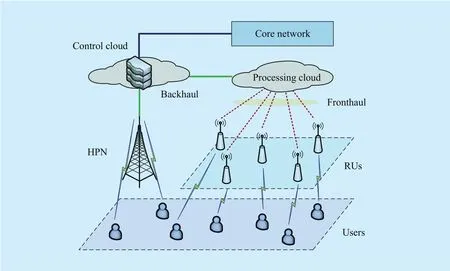
Fig.1 Network architecture of C-HetNets given in [5]
Firstly, we establish a system model of C-HetNets with wireless fronthaul, and propose a cooperation RU scheduling scheme to improve the transmission reliability of fronthaul. Unlike the existing works of the performance analysis of HetNets and C-HetNets with ideal fronthaul assumptions, such as [16],[17], and [18], fronthaul constraint of C-Het-Nets is considered in this paper. In particular,by employing Possion point process (PPP)theory, the pathloss of each fronthaul link is attached as a mark with each RU, which can capture the fronthaul capacity constraint, and the RUs are scheduled due to the condition of fronthaul to improve the transmission performance and energy efficiency in C-HetNets.
Secondly, based on our established C-Het-Net system model, a tight tractable lower bound of coverage probability is derived for open access strategy. Moreover, by studying the impact of density ratio on the access preference of users, a coverage probability constraint of fronthaul can be derived to ensure the transmission performance.
Finally, the simulation results are provided to verify the theoretical results and show the impact of fronthaul constraint.
The rest of this paper is organized as follows. Section II describes the system model,and the open access scheme in C-HetNets is also introduced. In Section III, the coverage probability of open access scheme in C-Het-Nets is studied, and a tractable lower bound is derived. Moreover, further discussion of analytical results is provided to show some insights. The simulation results are shown in Section IV, followed by the conclusion in Section V.
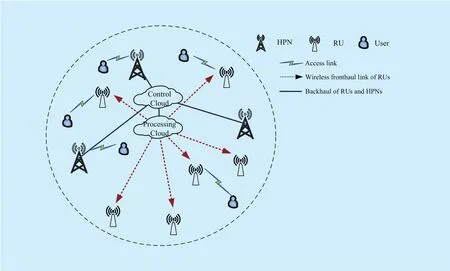
Fig.2 Illustration of studied system model
II. SYSTEM MODEL
Consider a downlink transmission scenario in C-HetNets, which is illustrated in Fig. 2.Compared with conventional cloud computing-based networks, high-power nodes(HPNs) are employed to improve the mobile connectivity and energy efficiency. Due to their spatial distribution feature, the locations of both the HPNs and the users are modeled as two independent homogenous PPPs, which are denoted as ΦHand ΦU, and the corresponding density can be given as λHand λU, respectively [16]–[18]. Moreover, RUs belonging to the same cluster are connected to a common processing cloud through wireless fronthaul links, which can be scheduled cooperatively.Unlike fiber fronthaul links, the implementation of wireless fronthaul allows the RUs to formulate the cooperation cluster dynamically with much lower costs. The RUs and HPNs in the same cluster are controlled by a common control cloud via fiber backhaul. In this paper,the locations of RUs are modeled as a homogenous marked PPP ΦR(Lk) with a given density λR, where the mark Lkdenotes the length of wireless fronthaul link between the k-th RU Rkand the processing cloud.
2.1 Cooperative scheduling of RUs
In C-HetNets, the loadings of C-RANs can be relieved by the application of HPNs, and thus it is not necessary to use all the RUs simultaneously. To reduce the co-channel interference and improve the energy efficiency, the density of RUs should be reduced.Since only the RU that successfully decodes the message from the processing cloud can serve the users, the RU with better fronthaul links should be scheduled prior to the data transmissions. Due to the marked PPP-based model, it can be implemented by selecting the RUs with better pathloss conditions, which are decided by their marks. A ball B(Rk, lT)is formulated for each RU Rk∈ΦR(Lk), and it can be scheduled as an active RU if it is with the shortest fronthaul in B(Rk, lT),i.e., Lk≤Li, where ?Ri∈B(Rk, lT). Therefore,by following a Matern hard-core process as introduced in [27],can be given asAs introduced in [27],still is a homogenous PPP, and its density can be provided as
2.2 Open access strategy of user
In this paper, an open access strategy is employed, and each user chooses one single access point based on the access distance to ensure the transmission reliability. As introduced in [16] and [17], open access strategy allows the users to connect to either HPN or RU due to its channel condition only. Considering the differences of transmission capabilities between HPNs and RUs, a bias β is multiplied to balance the loadings. Without loss of generality, we focus on a user UT , and Rk and Hm are its nearest RU and HPN, respectively. Then the access rule of UT can be given as follows:

where dkdenotes the distance between UT and Rk, and rmis defined similarly for Hm. As introduced in [20], the optimal value of β to ensure that our studied open access strategy can achieve its best performance isPRand PHare the transmit power of RU and HPN, respectively, and it is related to the transmit power of HPN and RU only.
In this paper, we focus on an interference limit scenario, where the impact of noise on the access links can be ignored. Due to different access strategies given by (1), the received signal-to-interference ratio (SIR) of UTcan be expressed as
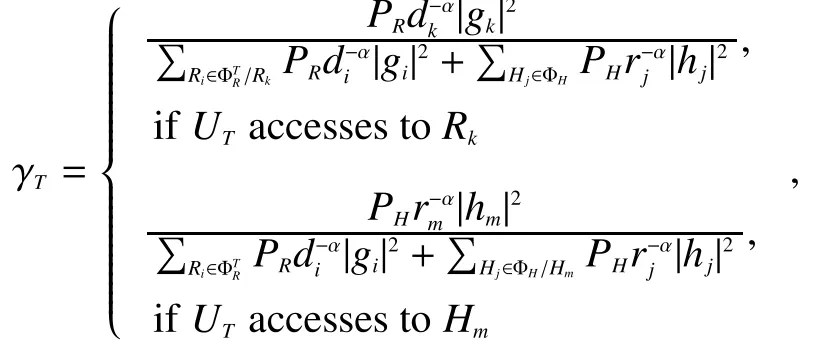
where gkand hmdenote the flat channel fading coefficients of the links between UTand Rkand Hm, giand hjare defined similarly for the interfere nodes Riand Hj, gk, gi, hm, hj~CN (0, 1), diand rjare the distances between UTand Riand Hj, and α denotes the path loss exponent.
III. PERFORMANCE ANALYSIS OF OPEN ACCESS STRATEGY IN C-HETNETS
In this section, the coverage performance of open access strategy in C-HetNets is studied.First, a tight tractable lower bound of the coverage probability can be derived based on the established stochastic geometry model. Then the impact of fronthaul links can be analyzed by employing the obtained theoretical results,where a constraint of fronthaul can be obtained.
3.1 Coverage probability of open access strategy in C-HetNets
As introduced previously, each user is allowed to access either one HPN or one RU flexibly by following the rules given in (1). Therefore,coverage probability of the open access strategy in C-HetNets is jointly decided by the performance of both cases. In particular, the coverage probability of UT can be defined as follows, which is the probability that the desired message can be detected successfully,

Lemma 1:When a user UTaccesses to its nearest HPN, a tight lower bound of its coverage probabilitycan be expressed as
where θ = PR/PHdenotes the power ratio,ν=μR/λHis the density ratio between scheduled RUs and HPNs, and T (s, α) denotes a function of a tractable integral, which can be given by


where a tractable lower bound ofgiven in (a) of (7) is derived by following from the constraintand (b) in (7) can be obtained by substitutinganddenote the nearest access points of RUs and HPNs, respectively, and the PDFs ofcan be given asandThen a tractable lower bound ofcan be derived as (8)based on (5) and (7) shown in the bottom at this page.
And Lemma 1 has been proved.
For each snapshot of the homogenous marked PPPwith a fixed number of RUs, the locations of its elements follow independent uniform distributions. Therefore, the distance between each RU and the processing cloud also follows a uniform distribution, i.e.,Then a tight lower bound ofcan be provided by the following lemma.
Lemma 2:When a useraccesses to its nearest RU, a tight lower bound of its coverage probabilitycan be expressed as


Proof: Wefirst focus on the coverage probability of fronthaul linkand the key step is to derive the CDF of, which denotes the shortest length of wireless fronthaul links of RUs located inand then it can be expressed as (11) shown in the bottom at next page.
As introduced previously, the number of RUs located infollows Poisson distribution, whilefollows uniform distribution,and thenin (11) can be derived as(12) shown in the bottom at this page.
where (a) in eqref{eqn:pdf_l_k} follows from the series expansion of exponential functions. Thencan be given as (13)shown in the bottom at this page.
Then we study the coverage probability of access link whenaccesses to its nearest RU, which is defined byBy following a similar proof process of Lemma 1, a tight lower bound can be given as

And Lemma 2 can be proved by substituting (13) and the derived lower bound of
3) A Tractable Lower Bound ofBased on the analytical results of coverage probability for both cases, which are provided by Lemma 1 and Lemma 2, respectively, a tractable lower bound ofcan be shown in the following theorem.
Theorem 3:For our studied two-tier C-HetNet scenario, a tight lower bound of coverage probability for a usercan be expressed as (14) shown in the bottom at this page.
Proof: When the open access strategy is employed, (14) in Theorem 3 can be proved by substituting the theoretical results in Lemma 1 and Lemma 2 into (3).
3.2 Further discussion of analytical coverage performance in theorem 3
1) The Impacts of Density Ratio v on: As shown in (14), the coverage probability of open access scheme is determined by the density ratio v, and the relationship betweenand v can show the access preference ofTo evaluate the impact of density ratio insightfully, the following derivative ofcan be expressed (15) shown in the bottom at this page.
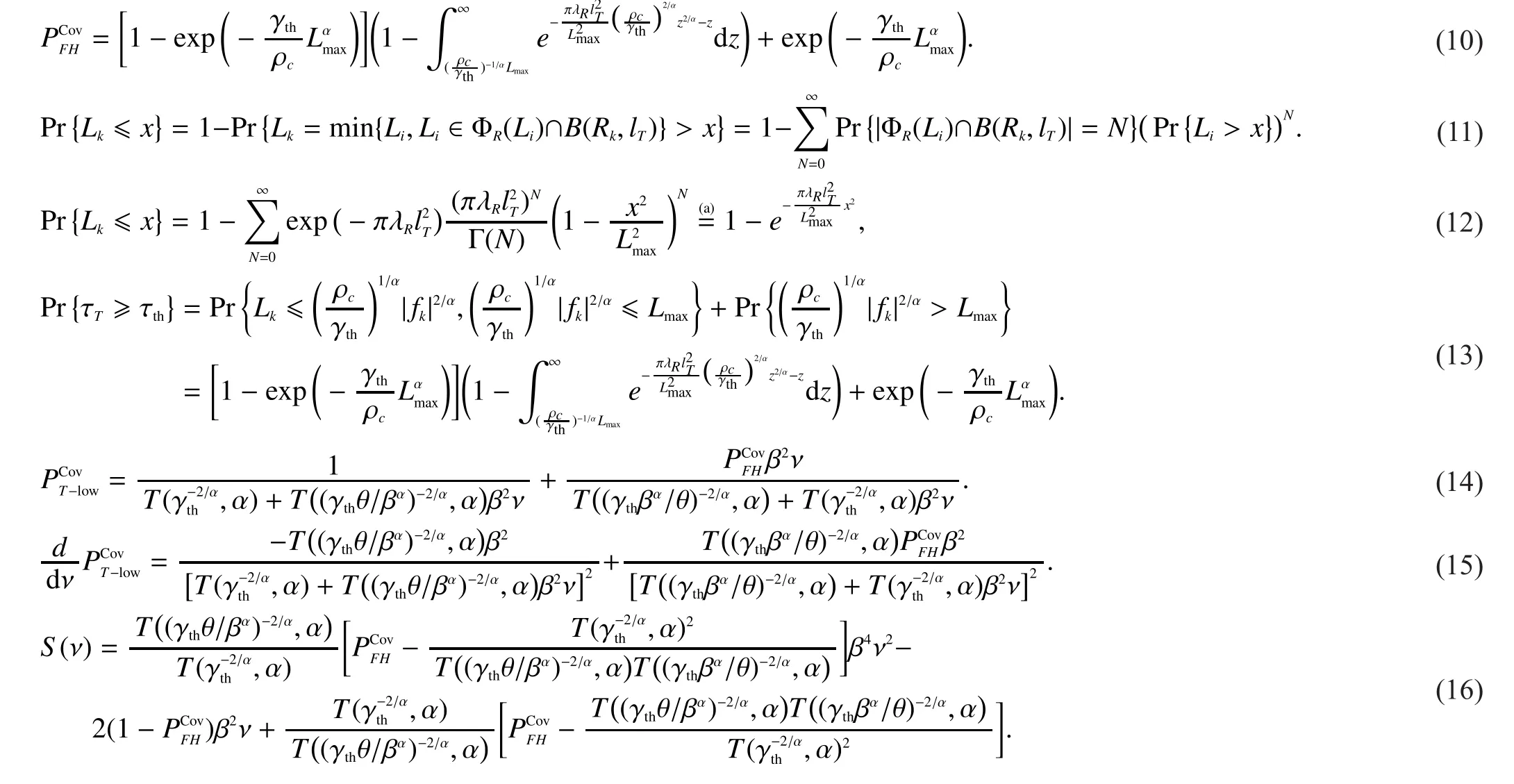
Then the sign of the derivative given by(15) is determined by the following function(16) shown in the bottom at this page.

Fig.3 Coverage probability of open access strategy in C-HetNets
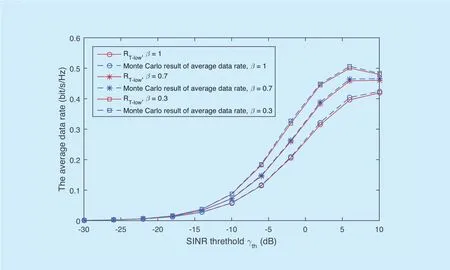
Fig.4 The average data rate of open access strategy in C-HetNets
Case 1)given in (16) is a univariate quadratic function, and its change trend is decided by the root discriminant, which can be expressed as (17) shown in the bottom at next page.
Case 2)Similar to Case 1),still has two rootsandsince the root discriminant. However, by following (18), the product of two rootsandis positive in this case. To judge the sign ofandtheir summation can be expressed as (19) shown in the bottom at this page.
Case 3)Based on (16),can be derived as


Corollary 4: Open access strategy can achieve the optimal coverage performance in C-HetNets when the coverage probability of fronthaul satisfies the following constraint(21) shown in the bottom at this page.
IV. SIMULATION RESULTS
To evaluate the coverage performance of open access strategy in C-HetNets with wireless fronthaul, simulation results are provided in this selection. In particular, the maximum length of fronthaul ism, and the radius of RU cooperative schedule region isThe densities of HPNs and RUs are set asrespectively,and the pathloss exponent isThe transmit power of cloud BBU pool, HPN and RU is set asdBm anddBm,respectively.
In Fig. 3, the coverage performance of the open access strategy is plotted, where the access bias parameter can be given asrespectively. In Fig. 4, the average data rate of open access strategy in C-Het-Nets is evaluated, which can be expressed asThe SNR threshold of fronthaul in Fig. 3 and Fig. 4 is set asAs shown in thefigure, a lower bound of average data rate, which is denoted asis provided. The average data rate increases asincreases in low SINR threshold region, since high data rate transmissions can be supported.Note that the coverage probability decreases fast in high SINR threshold region, and thus the average data rate keeps decreasing whenis high, i.e.,dB whenin Fig.4. Moreover, the simulation results in Fig. 3 and Fig. 4 show that the numerical results of the derived lower bound is quite close to the Monte Carlo results, which verify the accuracy of our theoretical results.
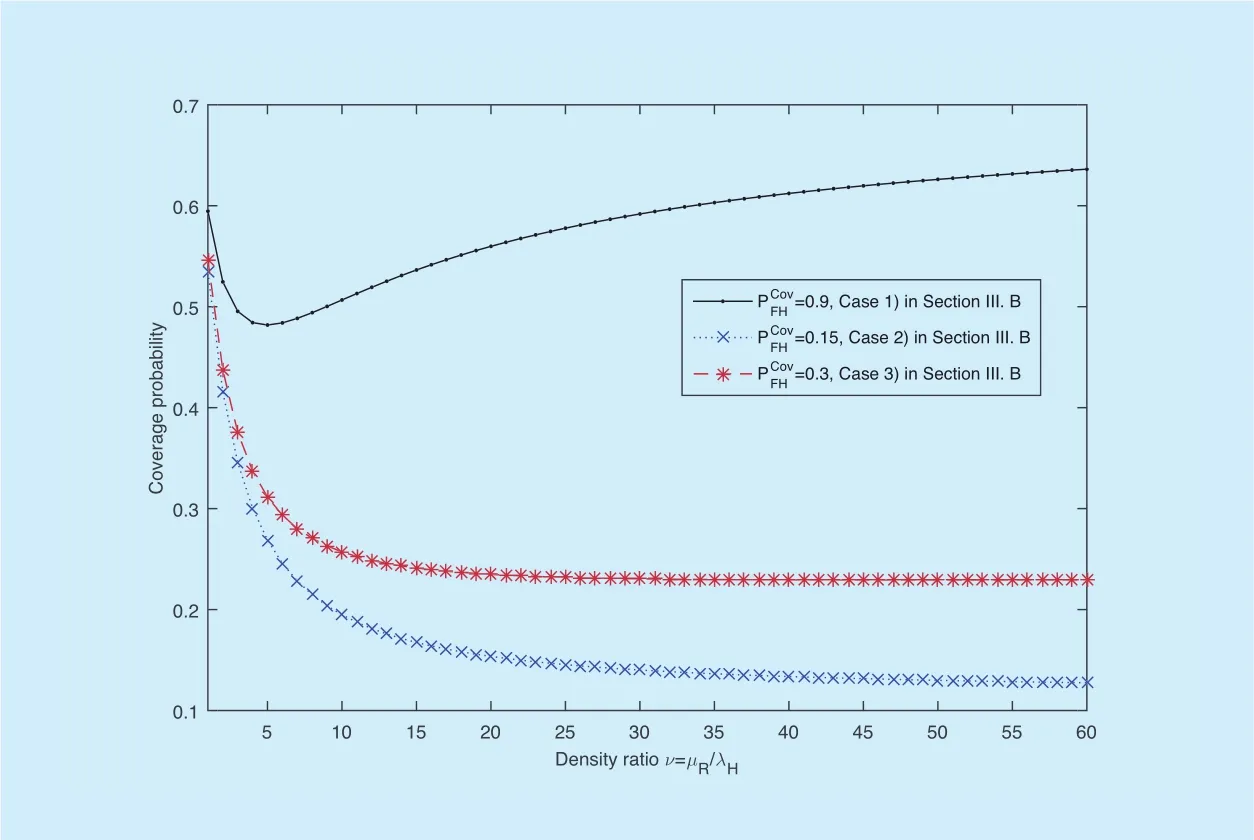
Fig.5 Coverage probability with different fronthaul constraint in C-HetNets

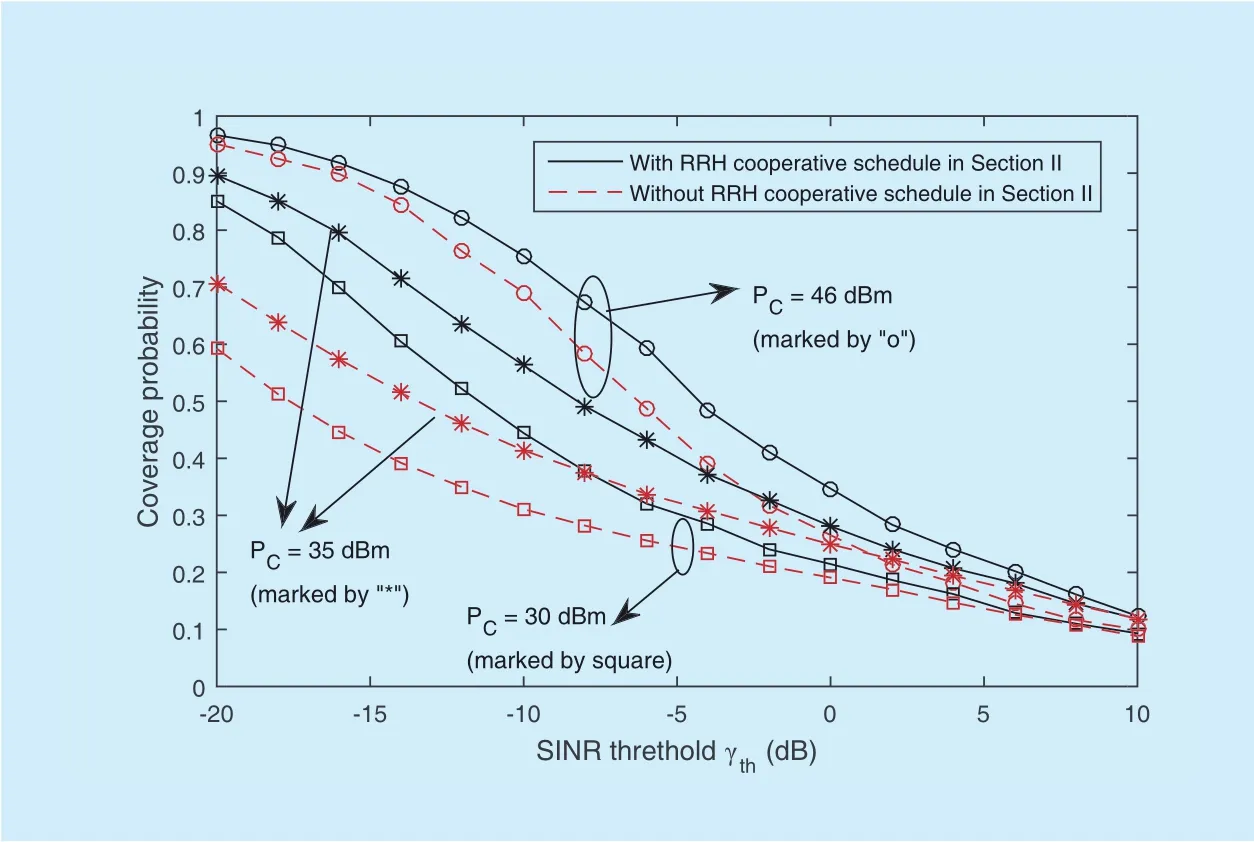
Fig.6 Performance comparison between open access strategies with and without RU cooperative schedule in C-HetNets
Moreover, the impacts of the density ratio are evaluated in Fig. 5. In particular,the fronthaul coverage probability is set asrespectively, and the SINR threshold is set asdB. As shown in thefigure, the coverage performance ofis a decreasing function with respect to the density ratio v when the channel quality of fronthaul is not good enough, i.e.,0.15 and 0.3. Such tendency changes when the RUs are with good fronthaul links, and the total coverage probability keeps increasing in the high density ratio region whenThese simulation results imply the access preference of users with different channel conditions of fronthaul, which is consistent to analytical results in Section III. Fig. 6 is provided to show the impacts of fronthaul in C-HetNet,where the SNR threshold of fronthaul is set asAs shown in the figure, the user chooses to access its nearest RU without considering the channel condition of fronthaul in non-cooperative scheduling scheme. The simulation results verify that cooperative RU scheduling is necessary to achieve the transmission performance gains in C-HetNets.
V. CONCLUSION
In this paper, the performance of open access strategy in C-HetNets has been studied. In particular, we focused on the downlink transmission scenario in C-HetNets with wireless fronthaul links. By establishing a stochastic geometry-based system model, which can characterize both the network topology and the capacity constraint of fronthaul, a trackable tight lower bound of the coverage probability has been derived. Based on the analytical results, a performance constraint of fronthaul has been obtained to ensure the coverage probability of the open access strategy. Finally, the simulation results have been given to verity the accuracy of derived theoretical results and show the impacts of fronthaul links.
ACKNOWLEDGEMENT
This paper was supported in part by the National Natural Science Foundation of China(Grant 61501045), in part by State Major Science and Technology Special Projects (Grant 2016ZX03001017-004).
[1] H. Zhang, C. Jiang, J. Cheng, and V. C. M. Leung,“Cooperative interference mitigation and handover management for heterogeneous cloud small cell networks,”IEEE Wireless Commun.,vol. 22, no. 3, pp. 92-99, June 2015.
[2] M. Peng, C. Wang, J. Li, H. Xiang, and V. Lau,“Recent advances in underlay heterogeneous networks: Interference control, resource allocation, and self-organization, ”IEEE Commun.Survey & Tutorial, vol. 17, no. 2, pp. 700-729,second quarter, 2015.
[3] M. Peng, D. Liang, Y. Wei, J. Li, and H. Chen,“Self-configuration and self-optimization in LTE-Advanced heterogeneous networks,”IEEE Commun. Mag., vol. 51, no. 5, pp. 36-45, May 2013.
[4] M. Peng, C. Wang, V. Lau, and H. V. Poor, “Fronthaul-constrained cloud radio access networks:Insights and challenges,”IEEE Wireless Commun., vol. 22, no. 2, pp. 152-160, Apr. 2015.
[5] M. Peng, Y. Li, Z. Zhao, and C. Wang, “System architecture and key technologies for 5G heterogeneous cloud radio access networks,”IEEE Network, vol. 29, no. 2, pp. 6-14, Mar. 2015.
[6] M. Peng, S. Yan, K. Zhang, and C. Wang,“Fog-computing-based radio access networks:Issues and challenges,”IEEE Network, vol. 30,no. 4, pp. 46-53, July 2016.
[7] M. Peng, Y. Li, J. Jiang, J. Li, and C. Wang, “Het-erogeneous cloud radio access networks: A new perspective for enhancing spectral and energy efficiencies,”IEEE Wireless Commun., vol. 21, no.6, pp. 126-135, Dec. 2014.
[8] Q. C. Li, R. Q. Hu, Y. Xu, and Y. Qian, “Optimal fractional frequency reuse and power control in the heterogeneous wireless networks,”IEEE Trans. Wireless Commun., vol. 12, no. 6, pp.2658-2668, June 2013.
[9] D. L.-Perez, I. Guvenc, G. Roche, M. Kountouris,Tony Q. S. Quek, and J. Zhang, “Enhanced intercell interference coordination challenges in heterogeneous networks,”IEEE Wireless Commun.,vol. 18, no. 3, pp. 22-30, June 2011.
[10] K. Ahuja, Y. Xiao, and M. Schaar, “Distributed interference management policies for heterogeneous small cell networks, ”IEEE J. Select. Areas Commun., vol. 33, no. 16, pp. 1112-1126, June 2015.
[11] M. Hong and Z.-Q. Luo, “Distributed linear precoder optimization and base station selection for an uplink heterogeneous network,”IEEE Trans. Signal Process., vol. 61, no. 12, pp. 3214-3228, June 2013.
[12] M. Gerasimenko, D. Moltchanov, R. Florea, S.Andreev, Y. Koucheryavy, N. Himayat, S.-P. Yeh,and S. Talwar, “Cooperative radio resource management in heterogeneous cloud radio access networks,”IEEE Access, vol. 3, pp. 397-406, May 2015.
[13] S.-Y. Lien, S.-C. Hung, K.-C. Chen, and Y.-C. Liang, “Ultra-low-latency ubiquitous connections in heterogeneous cloud radio access networks,”IEEE Wireless Commun., vol. 22, no. 3, pp. 22-31,June 2015.
[14] M. Peng, X. Xie, Q. Hu, J. Zhang, and H. V. Poor,“Contract-based interference coordination in heterogeneous cloud radio access networks,”IEEE J. Select. Areas Commun., vol. 33, no. 6, pp.1140-1153, June 2015.
[15] C. Ran, S. Wang, and C. Wang, “Balancing backhaul load in heterogeneous cloud radio access networks,”IEEE Wireless Commun., vol. 22, no.3, pp. 42-48, June 2015.
[16] H. S. Dhillon, R. K. Ganti, F. Baccelli, and J. G. Andrews, “Modeling and analysis ofK-tier downlink heterogeneous cellular networks,”IEEE J.Select. Areas Commun., vol. 30, no. 3, pp. 550-560, Apr. 2012.
[17] Y. S. Soh, T. Q. S. Quek, M. Kountouris, and H.Shin, “Energy efficient heterogeneous cellular networks,”IEEE J. Select. Areas Commun., vol. 31,no. 5, pp. 840-850, May 2013.
[18] M. A. Abana, M. Peng, Z. Zhao, and L. A. Olawoyin, “Coverage and rate analysis in heterogeneous cloud radio access networks with device-to-device communication,”IEEE Access, vol.4, pp. 2357-2370, May 2016.
[19] M. Zandi, M. Dong, and A. Grami, “Dynamic spectrum access via channel-aware heterogeneous multi-channel auction with distributed learning,”IEEE Access, vol. 4, pp. 2357-2370,May 2016.
[20] W. C. Cheung, T. Q. S. Quek, and M. Kountouris,“Throughput optimization, spectrum allocation,and access control in two-tier femtocell networks,”IEEE J. Sel. Areas Commun., vol. 30, no. 3,pp. 561-574, Apr. 2012.
[21] S. Mukherjee, “Distribution of downlink SINR in heterogeneous cellular networks,”IEEE J. Select.Areas Commun., vol. 30, no. 3, pp. 575-585, Apr.2012.
[22] G. Nigam, P. Minero, and M. Haenggi, “Coordinated multipoint joint transmission in heterogeneous networks, ”IEEE Trans. Commun., vol.62, no. 11, pp. 4134-4146, Nov. 2014.
[23] J. G. Andrews, R. K. Ganti, M. Haenggi, N. Jindal,and S. Weber, “A primer on spatial modeling and analysis in wireless networks,”IEEE Commun. Mag., vol. 48, no. 11, pp. 156-163, Nov.2010.
[24] M. Peng, S. Yan, and H. V. Poor, “Ergodic capacity analysis of remote radio head associations in cloud radio access networks,”IEEE Wireless Commun. Letters, vol. 3, no. 4, pp. 365-368, Aug.2014.
[25] Z. Ding and H. V. Poor, “The use of spatially random base stations in cloud radio access networks,”IEEE Signal Process. Letters, vol. 20, no.11, pp. 1138-1141, Nov. 2013.
[26] S. Park, O. Simeone, O. Sahin, and S. Shamai,“Fronthaul compression for cloud radio access networks: Signal processing advances inspired by network information theory,”IEEE Signal Process. Mag., vol. 31, no. 6, pp. 69-79, Nov. 2014.
[27] M. Haenggi and R. K. Ganti, “Interference in large wireless networks,”Foundations and Trends in Network., vol. 3, no. 2, pp. 127-248,2008.
[28] C. Yang, Y. Yao, Z. Chen, and B. Xia, “Analysis on cache-enabled wireless heterogeneous networks,” accepted byIEEE Trans. Wireless Commun., [Online]. Available: http://ieeexplore.ieee.org/stamp/stamp.jsp?tp=&arnumber=7194828.
- China Communications的其它文章
- High-Performance Beamformer and Low-Complexity Detector for DF-Based Full-Duplex MIMO Relaying Networks
- Action Recognition with Temporal Scale-Invariant Deep Learning Framework
- An Open IoT Framework Based on Microservices Architecture
- Distributed Document Clustering Analysis Based on a Hybrid Method
- RGB Based Multiple Share Creation in Visual Cryptography with Aid of Elliptic Curve Cryptography
- Orchestrating Network Functions in Software-Defined Networks

